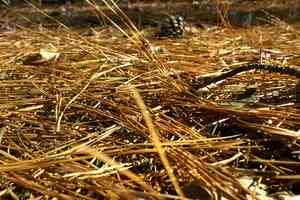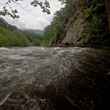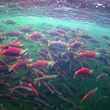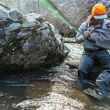A study published yesterday in the journal Environmental Science and Technology revealed disturbing new information about troubled Blacklick Creek in western Pennsylvania. The study, which sought to investigate the effects of the disposal of fracking wastewater by water treatment facilities into Pennsylvania's waterways, found vastly increased concentrations of naturally occurring radioactive materials in stream sediments near wastewater disposal sites. Concentrations of radium, a naturally occurring isotope that is 3 million times more radioactive than uranium, in these stream sediments were found to be around 200 times higher than both normal background levels of other area sediments including tested sediments from upstream locations.
Blacklick Creek, which is situated about an hour's drive from both the city of Pittsburgh and some of Pennsylvania's most storied trout waters, has a somewhat lengthy history of water quality issues thanks to acid mine drainage. After almost two decades of stream improvements efforts, however, the stream had begun to exhibit signs of life. A 2011 survey by the Pennsylvania Fish and Boat Commission found encouraging signs of fish beginning to return to the creek, with small specimens of eight different warm water species of fish discovered in the creek.
The sediments with the highest concentrations of radium were found adjacent to and up to 200 meters downstream of the Josephine Brine Treatment Facility in Black Lick, PA, which regularly processes wastewater transported from hydraulic fracturing operations. While the study found that processing by the treatment facility greatly reduced the levels of radioactive materials in fracking wastewater (by greater than 90%), it noted that the subsequent discharge of that treated effluent "nevertheless reduces the quality of downstream surface water and sediments." In fact, radium levels discovered in Blacklick Creek sediments exceeded U.S. management standards that would classify those sediments as toxic solid waste and require they be transported to a radioactive waste disposal facility.
Though radium and other elements are considered NORM (naturally occurring radioactive materials), modern industrial practices such as hydraulic fracturing can greatly increase and concentrate the presence of these elements. The resulting materials, termed TENORM (technologically enhanced naturally occurring radioactive material), are still widely unregulated. In fact, there are currently no federal regulations specifically controlling TENORM, though parts of other federal laws do regulate segments of the TENORM industry. At the state level, the situation is largely similar, though 13 states (including Pennsylvania) have regulations pertaining to TENORM.
When technological practices increase the concentrations of these naturally occurring elements -- for which humans and other organisms are accustomed to exposure to at normal levels -- the impacts can be significant. The study noted that "the accumulation of radium in sediments locally could pose significant ecological risks to benthic organisms in particular." In trout streams, benthic organisms represent some of a trout's dietary staples and include mayflies, caddisflies, stoneflies, midges and more. Radium is known to bioaccumulate in fish and magnify up the food chain.
The study found that, even after treatment, the of geochemical signature of Marcellus wastewater is apparent in water and sediment downstream of the treatment facility, producing a discernible impact on water quality. In addition to suggesting further study on the effects of these impacts, the study recommended that more advanced, existing treatment methods should be used to prevent discharge of toxic compounds into the environment.































Comments